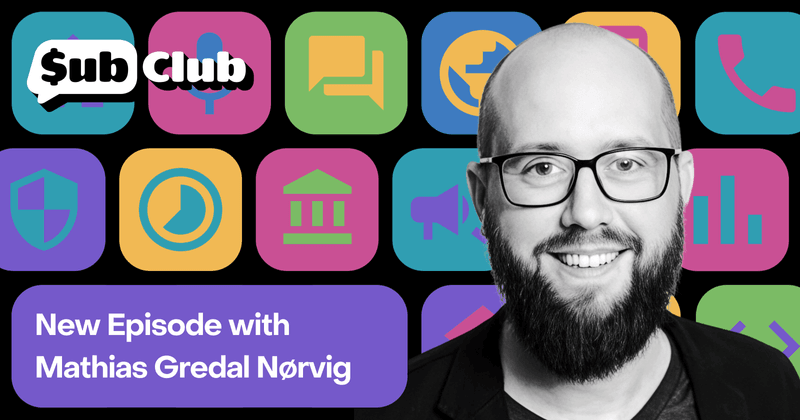When you think about the most successful apps of all time, Subway Surfers should probably come to mind. Released in 2012 by the Denmark-based gaming studio SYBO, Subway Surfers is an endless runner mobile game that has achieved incredible global popularity and longevity (to date, it has over 4.5B downloads).
This week on the Sub Club podcast, we spoke with SYBO CEO Mathias Gredal Nørvig. We asked Mathias about the strategies he and his team have employed over the years to build a freemium mobile gaming app that balances generating revenue and preserving a great user experience that keeps users coming back for more.
Riding the virality wave
When you’re building a subscription app business, one of the biggest decisions you have to make is how much of your ad budget should go toward paid advertising. It may come as a surprise, but SYBO actually doesn’t spend much on paid. Instead, they’ve invested in a talented in-house creative marketing team that churns out organic ads to both create and ride viral waves. Case in point, when the popular Netflix show Squid Game was released in 2021, the SYBO team made a TikTok video referencing a moment in the show with the Subway Surfers logo cleverly superimposed. Not every campaign is a hit, but the ones that do take off get millions of views and lead to major spikes in searches and downloads across platforms.
When asked about SYBO’s ad spend, Mathias said, “The short answer is that we spent nothing — we spent salaries. So it��’s all organic, but it’s also fair to say that we use very small budgets to boost things when we see that they go viral.” By choosing to invest in people rather than pouring most of their ad budget into paid advertising, SYBO has created a content marketing flywheel that punches above its weight. “They are super nimble and very efficient at producing,” Mathias said. “The [content marketing] people that have helped us along the way and those that are helping us now are worth their own weight in gold.”
Ads done right
The perennial question with the freemium model is how to generate revenue without creating a frustrating user experience. Like many free-to-play mobile games, Subway Surfers includes rewarded ads as a way for users to “pay” for the game using their attention rather than money. These ads allow players in tier-two and tier-three markets (people who may never subscribe) to contribute value as they enjoy the free app experience.
But Mathias and his team are careful to monitor what kind of content the ad networks serve up to Subway Surfers players. Given that a large portion of their user base are minors, the SYBO team has safeguards to protect these users in particular from viewing ad content that could be considered objectionable or harmful. “When you install the game, you show your age, and if you are younger than the legal age in your country, then you get placed in what we call the ‘copper’ segment,” Mathias said. “And if you’re in the copper group … you are not shown anything that would not be copper-compliant. But even [adult users] should not be able to see ads for gambling, guns, pornography, or anything that is R-rated. And that’s because we don’t believe that that’s the way we should be making business.”
All-access pass?
We’ve talked before on the Sub Club podcast about how app businesses can take advantage of alternate and hybrid monetization strategies beyond standard subscription tiers. If you think about it, there’s a pretty big gap between completely free access and a $99/year paid subscription — and where there’s a gap, there’s usually an opportunity. With millions of players around the world, the mobile gaming industry has been at the forefront of monetization, and one thing app businesses can learn from it is that sometimes the subscription model doesn’t make sense. As Mathias points out, “We all have these discoveries where we realize we’ve been spending a hundred dollars more than we wanted on something that we haven’t used since last March, and that’s an annoying feeling.”
For some apps, day passes or season passes can be a great monetization strategy — particularly for apps that don’t fit the mold of a standard subscription app. Think about a document scanning app that the user really only needs to use once to accomplish a task, or a skiing app that users only need to use during the peak ski season. “The season pass gives you a very clear overview of ‘these are the things you can get in this period of time if you spend this amount of money,’” Mathias said. “And then it requires you to engage with the app or game, and it requires you to play to get to it, but it unlocks a separate track of rewards.” Giving users more options to pay with one-time consumables, day passes, or season passes allows apps that otherwise struggle to monetize with subscriptions to generate revenue while also providing a better user experience.
Conclusion
Mobile gaming apps are often ahead of the curve when it comes to user acquisition and retention. Prioritizing free access that’s made possible by rewarded ad videos and hybrid monetization strategies like season passes, mobile gaming apps like Subway Surfers are (pun intended) playing the long game — providing a fun, accessible freemium app experience that keeps users coming back for more. So what can other mobile apps learn from their success? As Mathias puts it, “Monetization and gamification … is about figuring out how to make the user journey as frictionless as possible.”

